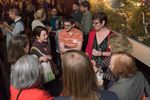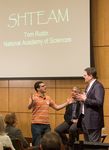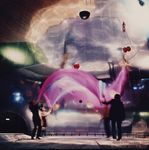Art & Science Integration - Cpnas
←
→
Page content transcription
If your browser does not render page correctly, please read the page content below
MARCH 2016 Exploring the intersection of Research, Innovation, and Social Engagement Art & Science Integration The D.C. Art Science Evening Rendezvous (DASER) is a discussion forum organized by Cultural Programs of the National Academy of Sciences (CPNAS), held 6-8 times annually. DASER fosters community and con- versation around the intersections, and interweaving, of art, science, and culture. On March 24, 2016, CPNAS hosted a program exploring the theme of Art & Science Integration. Speakers were Patrick McCray, Tom Rudin, Itai Cohen, and Margaret MacDonald. Tom Di Liberto made a special guest appearance (see page 4 for biographies). The discussion was moderated by JD Talasek. Lorie Mertes, Director of Public Programs, National Museum of Women in Arts, Washington, D.C., served as guest provocateur. We welcomed 150 guests to this sold out event which featured inspiring and thought-provoking conversations between the speakers and audience. The program was live-streamed and a recording is available on the NAS account at https://livestream.com/accounts/7036396/events/4518921. Videos of the presentations are available on CPNAS’ YouTube channel at: http://www.YouTube.com/CPNAS
PROGRAM HIGHLIGHTS
integrating STEM, the humanities and the arts in the
undergraduate and graduate curricula, instruction, labs
and other formal learning experiences. The presentation
highlighted the key elements of the 2 year study, which
is being launched spring 2016 and is funded in part by a
$750,000 grant from the Mellon Foundation. National
Oceanic and Atmospheric Administration (NOAA)
meteorologist Tom Di Liberto made a guest appearance
during Rudin’s presentation to demonstrate how move-
ment, music, art, and drama can be
used to teach scientific concepts.
This DASER revisited the themes of the No-
vember 2015 National Academies Keck Fu- In his talk, “Bringing Physics into the
tures Initiative (NAKFI) conference held in Fold,” Itai Cohen described the new
Irvine, CA. Several of the evening’s speak- design principles he and students at
ers had also been conference participants. Cornell University are uncovering to
NAKFI has been catalyzing interdisciplinary determine the shape, mechanics, and
research since 2003; the 2015 conference transformations of origami structures
focused on intersections of art and science. along with their usefulness in areas as
diverse as solar design, architecture,
Moderator JD Talasek kicked off the pro- and even fashion.
gram with a reading from Jenny Uglow’s
“The Lunar Men: Five Friends Whose
Curiosity Changed the World.” The Lunar
Society consisted of men who changed the
world including Erasmus Darwin, Josiah
Wedgwood, Joseph Priestly, and James Watt. The
evening continued with community share time
where approximately 10 audience members
gave short, fascinating descriptions of their
current projects at the intersection of art and
In her talk, “Culture as Medium,
science.
Exhibition as Experiment,”
Margaret MacDonald explored
Patrick McCray gave a talk titled “Re-Wiring Art
what form an exhibition can take
& Technology in the 1960s” based on the re-
to become responsive to work at
search he is conducting for a forthcoming book:
the boundaries of art, science, and
During the 1960s, artists and engineers came
technology. She looked at the what,
together in a series of formal collaborations.
where, and how of creating a site for
Besides creating interesting artistic works, these
experimentation and research within
efforts also built an infrastructure for future art
an exhibition, reflecting on historical
& technology collaborations and helped forge a
examples and revealing contempo-
new creative culture.
rary approaches. As part of her MFA
thesis in Curatorial Practice at Maryland Institute College
In a talk titled “Arts Integration: How Should We Do It? Who
of Art (MICA), she is curating an exhibition called
Should Do It? And Why Bother?,” Tom Rudin presented a
“Culture as Medium” featuring work by artists and
new initiative at the National Academies of Sciences,
scientists exploring the medium of bacteria.
Engineering, and Medicine examining the value of betterCAN I QUOTE YOU? Audience Responses
THIS CHANGED MY OPINION THE SPEAKER NAILED IT THE BEST PART WAS:
OF: WHEN:
Learning about the Board on Higher
Itai Cohen’s presentation changed my Itai Cohen was wonderfully engag- Education and Workforce’s new study
opinion of origami and its uses, both ing and truly made me think about to look for evidence of the value of
directly and by analogy. the intersection of art and science. integrated art and science.
Tom and Tom’s presentation changed The debate and interchange of ideas
my opinion of STEAM. during the discussion and Q & A
portion of the evening.
Itai Cohen made me realize how cool
physics is!
#DASER Social Media Highlights
@hannahcellist: So cool to learn about Itai Cohen’s work.
There was lively Twitter and Instagram activity during Origami influencing designs in tech, textiles...#DASER
the DASER program.
@drdarsci: “This nexus between art and science and
@nicolatriscott: Fascinating to hear that famed E.A.T. 9 science and art again has been very fruitful in my life.” -
Evenings was panned critically at the time! #DASER Cohen #DASER
@bluelikechagall: Ooo, very interested in @LeapingRobot’s @er4schen: Doing some intellectual exploration at
research on history of #sicart in 1960s-70s that wasn’t #DASER via @CPNAS tonight - how do we best integrate
included in my art history textbooks. #DASER art and science?
@lumanicious: Forget STEM and STEAM, let’s practice @vtjawo: Thomas Rudin discussing how you need to be
SHTEAM! #DASER adaptable; the skills you have now may not be relevant
in the future; arts humanities key. #DASER
@elpeanoh: Beethoven snippet used to sonically illustrate
the concept of wind and thunder in T. Rudin’s @lumanicious: So many debates here tonight at #DASER.
presentation. #DASER Also, a tango dancing lesson!
@drdarsci: Number one skill for mechanical engineer is Read the complete social media Storify archive:
empathy - to make sure you build the best machine https://storify.com/CPNAS/daser-art-science-integration.
possible - Rudin. #DASERSPEAKER BIOGRAPHIES
W. Patrick McCray is a professor in the Department of Itai Cohen is Associate Professor of Physics at Cornell
History at the University of California, Santa Barbara. In University, Ithaca, NY. Cohen is obsessed with matter in
2015-2016, he also holds the Charles Lindbergh Chair motion. At Cornell, his research has focused on investigat-
at the Smithsonian’s National Air and Space Museum. ing the behavior of microscopic and nanoscopic particles
McCray entered the historians’ profession via his original suspended in a fluid, exploring the mechanics of materials
career as a scientist. He has degrees in materials science ranging from biological tissues to origami inspired meta-
and engineering from the University of Pittsburgh (BS and materials, discovering the mechanisms used by insects
MS, 1989 and 1991) and the University of Arizona (PhD, during flapping flight, and determining how tango dancers
1996). While based in Washington, DC, McCray is con- and audiences at heavy metal concerts coordinate their
ducting research for a new book. Tentatively titled Re-Writ- movement. Understanding the out-of-equilibrium behaviors
ing Art, the project looks at the collaborations between of these systems remains one of the biggest challenges in
artists, engineers, and scientists from the 1960s onward. physics.
Margaret MacDonald is currently an MFA candidate in
Curatorial Practice at MICA. She is driven to foster work
at the intersection of art, science, and technology, and is
currently asking how an exhibition of artists’ works can be
a site for experimentation and a platform to present current
research. MacDonald has a multidisciplinary background
in both science and art. She holds a bachelor’s degree
in Art History and in Chemistry from Grinnell College and
a doctorate in Inorganic Chemistry from The University of
North Carolina at Chapel Hill.
Tom Di Liberto is a meteorologist and science commu-
Tom Rudin is the Director of the Board on Higher Educa- nicator. He works with Innovim at the Climate Prediction
tion and Workforce (BHEW) at the National Academies Center (CPC) inside NOAA. As the consulting meteorologist
of Sciences, Engineering, and Medicine—a position he for NOAA’s Climate.gov, he writes articles about weather
assumed in August 2014. BHEW provides government, and climate events, putting them into a climate perspec-
academic and industry leadership with analyses, insights, tive. He also is a member of CPC’s El Niño-Southern Oscil-
and recommendations designed to inform action on is- lation (ENSO) team forecasting the strength of developing
sues in higher education and the science and engineering El Niños and La Niñas. Tom was named America’s first
workforce. BHEW is a unit of the Policy and Global Affairs Scientist Idol in 2013 after winning a competition held at
Division of the Academies. the Annual Meeting of the American Association for the
Advancement of Science. He has given well-received,
humorous, informal science talks on weather and climate
across the US.TWITTER REPORT PHOTO CREDITS Page 1: From left to right, Patrick McCray, Gavin Zhang, and Cindy Bouchard. Pages 2-5: All photos by Kevin Allen Photo.
You can also read



























































